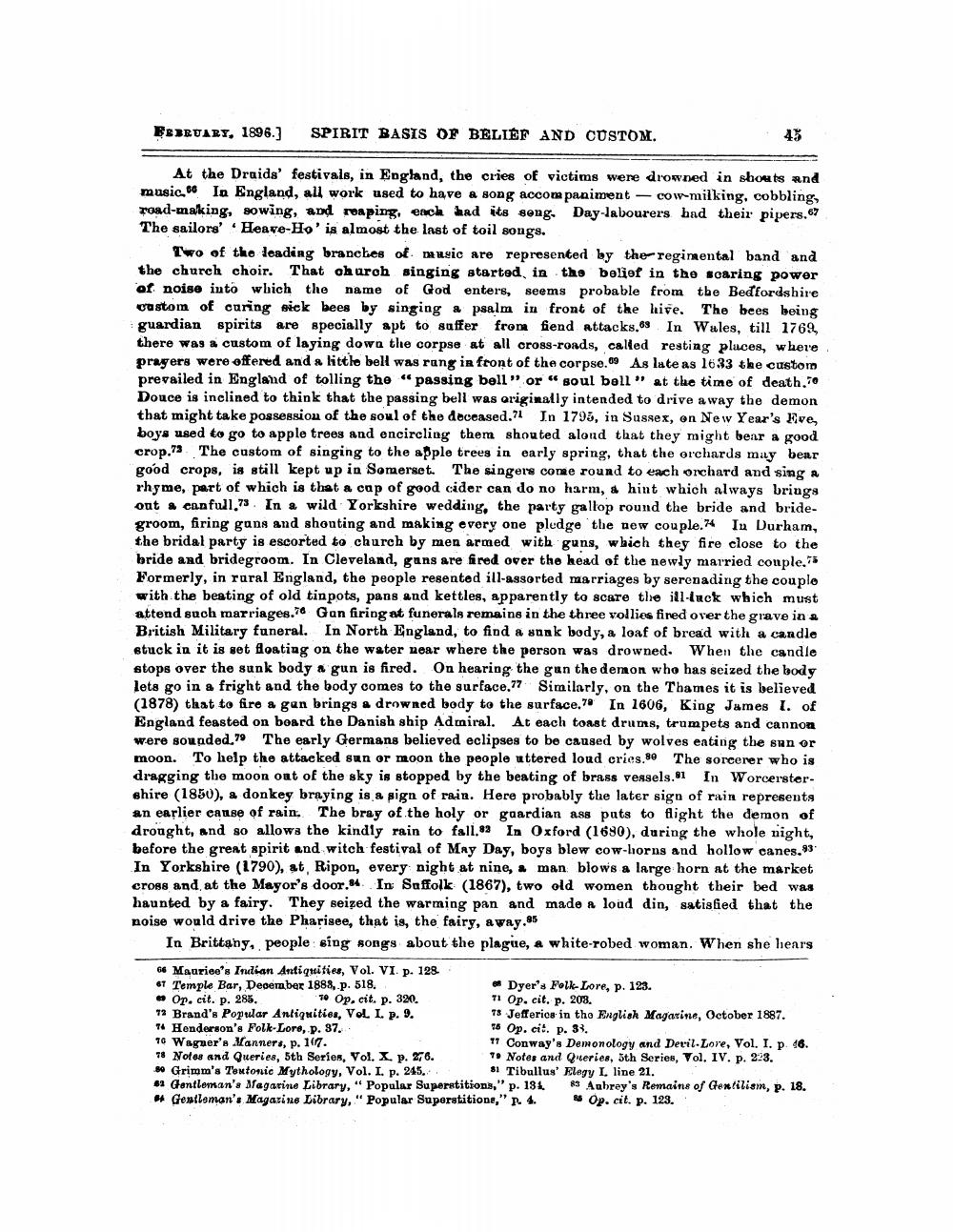________________
FEBRUARY, 1896.] SPIRIT BASIS OF BELIEF AND CUSTOM.
At the Draids' festivals, in England, the cries of victims were drowned in shouts and music. In England, all work used to have a song accompaniment cow-milking, cobbling, road-making, sowing, and reaping, each had its song. Day-labourers had their pipers, 67 The sailors' Heave-Ho' is almost the last of toil songs.
Two of the leading branches of music are represented by the regimental band and the church choir. That church singing started, in the belief in the scaring power of noise into which the name of God enters, seems probable from the Bedfordshire custom of curing sick bees by singing a psalm in front of the hive. The bees being guardian spirits are specially apt to suffer from fiend attacks. In Wales, till 1769, there was a custom of laying down the corpse at all cross-roads, called resting places, where prayers were offered and a little bell was rang in front of the corpse. As late as 1633 the custom prevailed in England of tolling the "passing bell" or "soul bell" at the time of death.70 Douce is inclined to think that the passing bell was originally intended to drive away the demon that might take possession of the soul of the deceased. In 1795, in Sussex, on New Year's Eve, boys used to go to apple trees and encircling them shouted aloud that they might bear a good crop.73 The custom of singing to the apple trees in early spring, that the orchards may bear good crops, is still kept up in Somerset. The singers come round to each orchard and sing a rhyme, part of which is that a cup of good cider can do no harm, a hint which always brings out a canfull.73 In a wild Yorkshire wedding, the party gallop round the bride and bridegroom, firing guns and shouting and making every one pledge the new couple. In Durham, the bridal party is escorted to church by men armed with guns, which they fire close to the bride and bridegroom. In Cleveland, gans are fired over the head of the newly married couple.75 Formerly, in rural England, the people resented ill-assorted marriages by serenading the couple with the beating of old tinpots, pans and kettles, apparently to scare the ill-luck which must attend such marriages.76 Gan firing at funerals remains in the three vollies fired over the grave in a British Military funeral. In North England, to find a sunk body, a loaf of bread with a candle stuck in it is set floating on the water near where the person was drowned. When the candle stops over the sunk body a gun is fired. On hearing the gun the demon who has seized the body lets go in a fright and the body comes to the surface.77 Similarly, on the Thames it is believed (1878) that to fire a gan brings a drowned body to the surface. In 1606, King James I. of England feasted on board the Danish ship Admiral. At each toast drums, trumpets and cannon were sounded." The early Germans believed eclipses to be caused by wolves eating the sun or To help the attacked sun or moon the people uttered loud cries.80 The sorcerer who is dragging the moon out of the sky is stopped by the beating of brass vessels.1 In Worcerstershire (1850), a donkey braying is a sign of rain. Here probably the later sign of rain represents an earlier cause of rain. The bray of the holy or guardian ass puts to flight the demon of drought, and so allows the kindly rain to fall.93 In Oxford (1680), during the whole night, before the great spirit and witch festival of May Day, boys blew cow-horns and hollow canes.93 In Yorkshire (1790), at, Ripon, every night at nine, a man blows a large horn at the market cross and at the Mayor's door. In Suffolk (1867), two old women thought their bed was haunted by a fairy. They seized the warming pan and made a loud din, satisfied that the noise would drive the Pharisee, that is, the fairy, away.95
moon.
In Brittany, people sing songs about the plague, a white-robed woman. When she hears
66 Maurice's Indian Antiquities, Vol. VI. p. 128.
67 Temple Bar, December 1888, p. 518.
Op. cit. p. 285.
10 Op. cit. p. 320.
72 Brand's Popular Antiquities, Vol. I. p. 9. 74 Henderson's Folk-Lore, p. 37.
To Wagner's Manners, p. 17.
78 Notes and Queries, 5th Series, Vol. X. p. 276.
Dyer's Folk-Lore, p. 123.
45
71 Op. cit. p. 208.
78 Jefferics in the English Magazine, October 1887. 16 Op. cit. p. 33.
77 Conway's Demonology and Devil-Lore, Vol. I. p. 46. 79 Notes and Queries, 5th Series, Vol. IV. p. 223.
81 Tibullus' Elegy I. line 21.
80 Grimm's Teutonic Mythology, Vol. I. p. 245.
62 Gentleman's Magazine Library," Popular Superstitions," p. 13&
Gentleman's Magazine Library," Popular Superstitions," p. 4.
83 Aubrey's Remains of Gentilism, p. 18. 8 Op. cit. p. 123.




